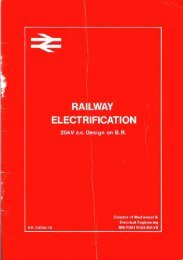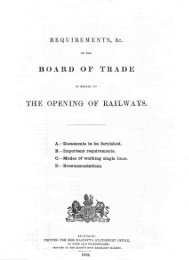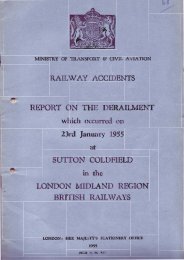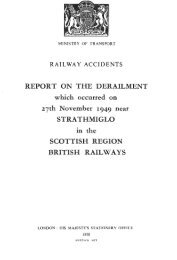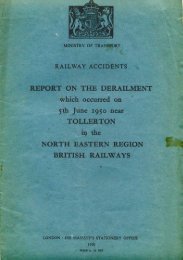R A I LT R AC K - The Railways Archive
R A I LT R AC K - The Railways Archive
R A I LT R AC K - The Railways Archive
You also want an ePaper? Increase the reach of your titles
YUMPU automatically turns print PDFs into web optimized ePapers that Google loves.
Route characteristics<br />
DESCRIPTION <strong>The</strong> Great Eastern Main Line runs from London to Norwich<br />
and has a number of branches. <strong>The</strong>re are four tracks between London and<br />
Shenfield; two with speeds of 80mph, and two of 70mph. Beyond Shenfield the<br />
main line is two track with speeds up to 100mph. <strong>The</strong> London–Norwich route<br />
and the routes to Southend, Braintree, Clacton, Walton and Harwich are<br />
electrified. <strong>The</strong> route also serves the ports of Felixstowe (the country’s largest<br />
container port) and Harwich.<br />
MAJOR STATIONS<br />
London Liverpool Street Our station regeneration work will begin in<br />
1999/2000 and has been timed to integrate with other proposals to improve<br />
passenger facilities. Other schemes we are considering with our customers<br />
include additional and improved ticketing and information facilities, as well as<br />
airline check-in facilities for services to Stansted Airport.<br />
BOTTLENECK ANALYSIS During the peak, demand growth can be met by<br />
the existing infrastructure, although some work will be needed at Stratford<br />
Route vision<br />
Our vision is to further develop the rail market share from the major centres of<br />
population in East Anglia, including Chelmsford, Colchester, Ipswich and Norwich,<br />
while providing attractive services for rural communities.<br />
<strong>The</strong> major modernisation completed in 1997 invested £220M in creating a<br />
route capable of reliably delivering 24 trains per hour into London from Shenfield<br />
over the main lines, in the peak, and up to 20 per hour over the ‘E’ lines<br />
between Ilford and London (18 per hour from Gidea Park). In the future, journey<br />
times will be reduced without loss of reliability or capacity wherever possible,<br />
with an aspiration of a ten-minute reduction from London to Norwich, a minute<br />
of which will be achieved in 2000 following OLE improvements.<br />
We will provide capacity sufficient for fast, frequent and regular passenger<br />
services across the route network. Early in the year 2000, we will complete the<br />
Station to improve connections to Docklands Light Railway and the Jubilee Line<br />
Extension. In the off peak, however, when GER and Anglia <strong>Railways</strong> are looking<br />
to develop their business, there is a bottleneck between Forest Gate Junction<br />
and Stratford, where fast and stopping services share a four-track railway with<br />
freight traffic crossing between the <strong>LT</strong>S and NLL routes on flat junctions. If freight<br />
traffic grows at predicted levels, up to five extra train paths an hour will be<br />
needed by 2008; the existing infrastructure only has the capacity to provide four<br />
extra paths.<br />
We are relieving the problem by installing new signals in 1999 between<br />
Woodgrange Park and South Tottenham (NLL), which will allow more dieselhauled<br />
freight services to be diverted away from Stratford, via Barking and<br />
Gospel Oak. This will allow off-peak passenger demand to be accommodated on<br />
the main line for the next ten years.<br />
By July this year we will have concluded our freight routeing strategy and<br />
agreed whether Felixstowe–Midlands and beyond trains will run on this route or<br />
via Peterborough. This year we will double freight capacity to the Po rt of<br />
F e l i x s t owe as we complete the Ipswich–Felixstowe Line modernisation project.<br />
resignalling of the Sheringham Line. This includes renewal of a number of level<br />
crossings, and provides the opportunity to introduce new signalling technology<br />
to the UK which will improve the reliability of the services for these rural<br />
communities.<br />
We are working with our customers to examine the potential for new<br />
stations on this route. Options include Southend Airport, Beaulieu Park<br />
(east of Chelmsford) and Braintree Freeport, which should open later this<br />
year. At a number of stations we are working with our customers to increase<br />
car-park capacity.<br />
<strong>The</strong> Franchising Director has asked us to assess the implications of<br />
increasing service frequency between Ipswich–Lowestoft to hourly. This<br />
would require the provision of an additional passing loop, probably at Beccles.<br />
221



